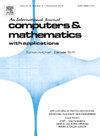Phase-field computation for 3D shell reconstruction with an energy-stable and uniquely solvable BDF2 method
IF 2.5
2区 数学
Q1 MATHEMATICS, APPLIED
引用次数: 0
Abstract
Three-dimensional (3D) reconstruction from points cloud is an important technique in computer vision and manufacturing industry. The 3D volume consists of a set of voxels which preserves the characteristics of scattered points. In this paper, a 3D shell (narrow volume) reconstruction algorithm based on the Allen–Cahn (AC) phase field model is proposed, aiming to efficiently and accurately generate 3D reconstruction models from point cloud data. The algorithm uses a linearized backward differentiation formula (BDF2) for time advancement and adopts the finite difference method to perform spatial discretization, unconditional energy stability and second-order time accuracy can be achieved. The present method is not only suitable for 3D reconstruction of unordered data but also has the effect of adaptive denoising and surface smoothing. In addition, theoretical derivation proves the fully discrete energy stability. In numerical experiments, the complex geometric models, such as Asian dragon, owl, and turtle, will be reconstructed to validate the energy stability. The temporal accuracy is validated by the numerical reconstructions of a Costa surface and an Amremo statue. Later, we reconstruct the Stanford dragon, teapot, and Thai statue to further investigate the capability of the proposed method. Finally, we implement a comparison study using a 3D happy Buddha. The numerical results show that the algorithm still has good numerical stability and reconstruction accuracy at large time steps, and can significantly preserve the detailed structure of the model. This research provides an innovative solution and theoretical support for scientific computing and engineering applications in the field of 3D reconstruction.
基于能量稳定且唯一可解BDF2方法的三维壳重建相场计算
点云三维重建是计算机视觉和制造业中的一项重要技术。三维体由一组体素组成,这些体素保留了分散点的特征。本文提出了一种基于Allen-Cahn (AC)相场模型的三维壳体(窄体)重建算法,旨在从点云数据中高效、准确地生成三维重建模型。该算法采用线性化后向微分公式(BDF2)进行时间推进,采用有限差分法进行空间离散化,可以实现无条件的能量稳定性和二阶时间精度。该方法不仅适用于无序数据的三维重建,而且具有自适应去噪和表面平滑的效果。此外,通过理论推导证明了该系统具有完全离散的能量稳定性。在数值实验中,将对亚洲龙、猫头鹰、海龟等复杂几何模型进行重构,验证能量稳定性。通过Costa表面和Amremo雕像的数值重建验证了时间精度。随后,我们重建了斯坦福龙、茶壶和泰国雕像,以进一步研究所提出方法的能力。最后,我们使用3D快乐佛进行了比较研究。数值结果表明,该算法在大时间步长下仍具有良好的数值稳定性和重建精度,并能较好地保留模型的细节结构。本研究为三维重建领域的科学计算和工程应用提供了创新的解决方案和理论支持。
本文章由计算机程序翻译,如有差异,请以英文原文为准。
求助全文
约1分钟内获得全文
求助全文
来源期刊

Computers & Mathematics with Applications
工程技术-计算机:跨学科应用
CiteScore
5.10
自引率
10.30%
发文量
396
审稿时长
9.9 weeks
期刊介绍:
Computers & Mathematics with Applications provides a medium of exchange for those engaged in fields contributing to building successful simulations for science and engineering using Partial Differential Equations (PDEs).
 求助内容:
求助内容: 应助结果提醒方式:
应助结果提醒方式:


